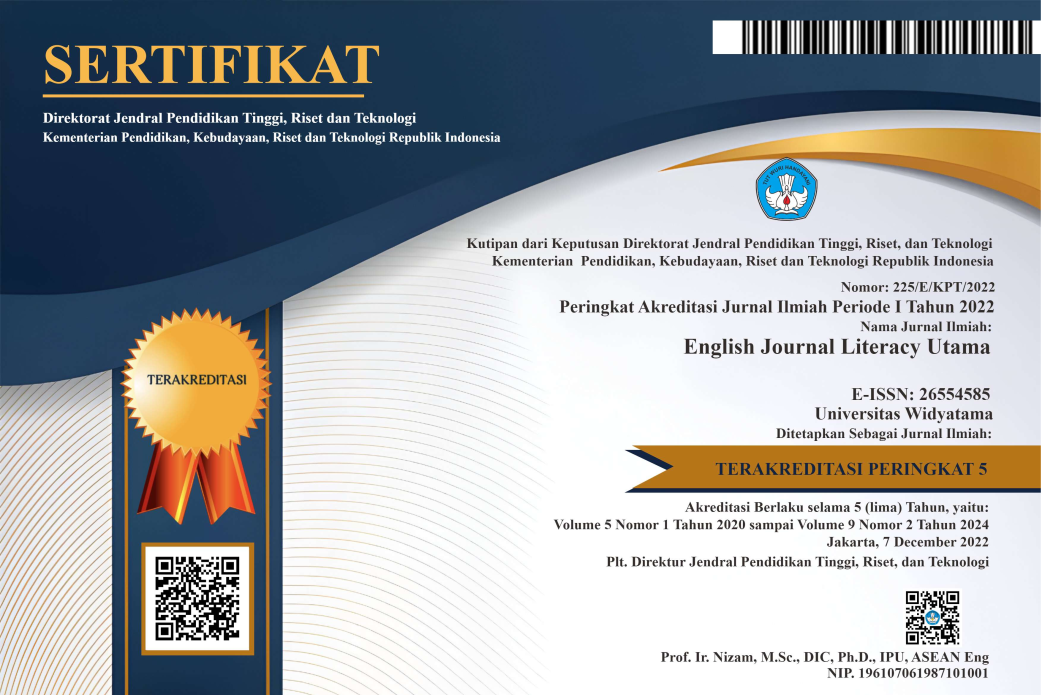How The Prepositional Phrase Arouses Ambiguity In Three Articles Published On Search.Ebscohost.com
DOI:
https://doi.org/10.33197/ejlutama.v7i1.189Keywords:
syntax, syntactic function, syntactic category, noun phrase, prepositional phrase, verb phrase, possessive determiner, relative clauseAbstract
This research is entitled How the Prepositional Phrase Arouses Ambiguity in Three Articles Published on Search.ebschost.com. The purpose of this research is to discuss some sentences containing prepositional phrase which enables the author to find its ambiguity and its solution. This prepositional phrase analysis is done by studying some previous articles found in Search.ebschost.com. The preposition phrase chosen to be analyzed refers to the preposition phrase which begins with the preposition “with”. The result that can be taken from this research shows that (1) the prepositional phrase may attach only to VP in particular sentence, while on the other hand, (2) it may attach both to VP and to NP so that the meaning of the sentence may be ambiguous. To avoid the ambiguity, the possessive determiners and the relative clauses may be used instead. The qualitative method was employed since it referred to the theoretical frames which consists of previous researches, findings, and theories.
References
Aarts, B. (2018). English syntax and argumentation. Bloomsbury Publishing.
Babacar, S. (2021). A contrastive study of the possessive determiners in english and seeree-siin. Hmlyan Jr Edu Lte, 2(2), 155–160.
Baldwin, T., & Aline, V. (2009). Prepositions in applications: A survey and introduction to the special issue. Computational Linguistics, 35(2), 119–149.
Bogdan, R., & knopp Biklen, S. (2003). Qualitative research for education: An introduction to theory and methods (Fourth Edition). Ally and Bacon.
Burton-Roberts, N. (2022). Analysing sentences: An introduction to english syntax (Fifth Edition). Routledge.
C. Ferstl, E. (2019). Context effects in syntactic ambiguity resolution: The location of prepositional phrase attachment. In Proceedings of the Sixteenth Annual Conference of the Cognitive Science Society, 295–300.
Chaer, A. (2012). Linguistik umum. PT Rineka Cipta.
Chomsky, N. (1965). Aspects of the theory of syntax. Cambridge: MA: MIT Press.
Crescentini, A., & Mainardi, G. (2009). Qualitative research articles: Guidelines, suggestions and needs. Journal of Workplace Learning, 21(5), 431–439.
H.Khan, I., & H. Hamdan, M. (2018). An analysis of prepositional-phrase attachment disambiguation. International Journal of Computational Linguistics Research, 9(2), 60–80.
Merlo, P., & Ferrer, E. E. (2006). The Notion of Argument In Prepositional Phrase Attachment. Computational Linguistics, 32(3), 341–378.
Nadh, K., & Huyck, C. (2012). A neurocomputational approach to prepositional phrase attachment ambiguity resolution. Neutral Computation, 24(7), 1906–1925.
O’Grady, W. (2008). Contemporary linguistic analysis: An introduction. Person Longman.
Radford, A. (2004). English syntax: An introduction. Cambridge University Press.
Schwarz, F. (2012). Situation pronouns in determiner phrases. Natural Language Semantic, 20(4), 431–475.
Thomas, L. (1993). Beginning syntax. Blackwell.
Wan Cho, D., & Lee, K. (2016). English relative clauses in science and engineering journal papers: A comparative corpus-based study for pedagogical purposes. Ampersand, 3, 61–70.
Downloads
Published
Issue
Section
License
Copyright (c) 2022 Dede ismail

This work is licensed under a Creative Commons Attribution-NonCommercial-ShareAlike 4.0 International License.
Creative Commons Attribution-ShareAlike 4.0 International License















